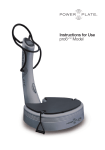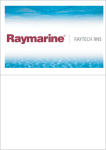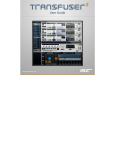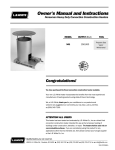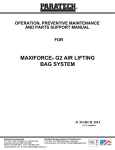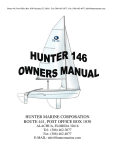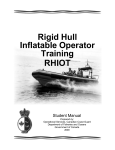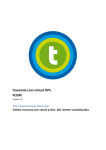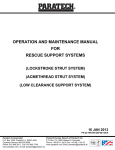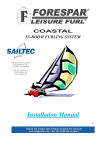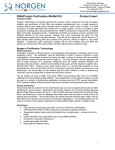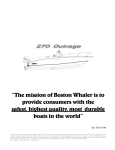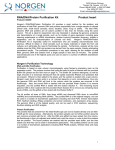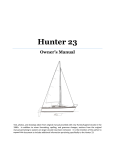Download heavy weather essentials - Beth and Evans Home Page
Transcript
© 2006 Beth A. Leonard & Evans Starzinger HEAVY WEATHER ESSENTIALS Seven boats abandoned and six people dead in the Sydney to Hobart race. Four boats lost and four dead in this year’s passage out of the tropics to New Zealand. Two boats abandoned in the Caribbean 1500. It’s been a tough year for the offshore sailing fleets and perhaps time for each of us to revisit our heavy weather preparations. Unlike many other sports, once out in the ocean we are committed. We can’t just decide to quit and go home to a warm bath. We have to keep going no matter what gets thrown our way and must be prepared to be self-sufficient in every contingency. Being prepared for heavy weather is one of the ocean sailor’s primary tests. Waves Define Heavy Weather Waves define heavy weather, not wind. In flat water a well-found vessel with appropriate storm canvas can sail right up through hurricane strength winds. However, a cubic yard of salt water weighs about one ton. The crest of even a small breaking wave could easily smash 10 tons of water on your deck at a velocity of 20kts. Such force can knock most yachts down, shatter ports and shear off deck hardware. A yacht can safely bob up and down on 100-foot high waves so long as they are not breaking. Breaking waves add the critical unstable ingredient that can suddenly transform an exhilarating but essentially benign situation into life-threatening danger. Breaking waves don’t mean foamy white wave caps that slosh over the toe rail. Breaking waves mean long curling over-hangings crests which dish up hammer blows to the hull, cause the rudder to lose its grip and go squirmy, and can be heard in advance down below roaring up on the boat. These signs require you to take action. Fortunately large breaking waves are rare. The Dashews report that during their +200,000 miles at sea they have spent less than 72 hours in ‘severe weather’. Experienced ocean voyagers and the ocean pilot charts both agree that the greater than force 8 conditions occur about 1% in the tropics and 3% in the higher latitudes (in the summer). Force 8 alone will usually not produce breaking waves. One of three concurrent factors is also necessary: When the strong winds blow across strong current (e.g. the Gulf Stream and Agulhas). A contrary current of only 2 knots may double wave heights according to The Scripps Institute of Oceanography. When large deep ocean swells meet shallow banks (e.g. the shallow shelf extending South of Madagascar or the Georges Banks east of Cape Cod). Sea Mounts pose a similar threat. We have personal experience where underwater landslides down the slopes of Sea Mountains created an single isolated steamroller breaking wave over the shallow mountaintop that swept our decks. Near the center of very deep low-pressure cells with winds over Force 10 which have shifted direction suddenly. The center of cyclones and extra-tropical ‘bombs’ like the Queen’s Birthday storm generate these types of conditions. The breaking waves caused by these conditions can overwhelm even the best-designed yacht. Wave tank testing by Southampton University indicated beam on breaking waves with a height 55% of hull length would easily overwhelm essentially all mono-hull form/ballast combinations. Further, all the designs could be rolled past 130 degrees by a breaking wave height of 35% LOA. The design factor with the highest impact on capsize resistance was roll inertia. However increasing the roll inertia of a given design by 50% increased the wave height needed to cause capsize by only 10-15%. This is a stunningly low impact, essentially negligible in the real world, where random rogue waves will be 200-300% bigger than the average waves. Trysail Smallest jib The simple fact that relatively small breaking waves can overwhelm even the most stable design suggests two imperatives. First, minimize your exposure to potential breaking wave conditions (e.g. shallow banks, strong ocean currents and deep lows) by exercising prudent routing and sailing efficiently to minimize time at sea. Second, if unavoidably caught in breaking wave conditions use tactics that minimize the probability of your being caught beam on to the breaking waves. Avoiding the Breaking Waves Avoiding breaking waves all together is the obvious objective. We know quite a number of circumnavigators who have done exactly that and never needed to use any storm tactics. It is quite feasible in a tropical circumnavigation, so long as you carefully route yourself around the cyclone seasons and avoid going directly over the tops of sea mountains. Avoiding major ocean currents is a bit more difficult, and used correctly they can speed you on your way. The rule is simply to get out of the current if a storm is approaching, and this is not too difficult as the major currents streams are typically only 25-100 miles wind. When rounding South Africa local thinking is to head inside the 100m sounding when a SW storm is approaching. This is well out of the main axis of the Agulhas current that centers about the 300-600m sounding. When making landfall on the East Coast of South Africa the East coast of America, you have to cross either the Agulhas or the Gulf Stream. These currents are far enough from any likely departure points that you can not leave with a clear ‘weather window’ to cross the current – you just have to take what you get when you get there. The best approach is in four steps: (1) have a very clear idea of where the current is, (2) assess the weather when approaching the current, (3) heave-to or run off outside the current stream if heavy weather is at all likely, (4) cross the stream as rapidly as possible when the weather is clear. This is one time we are happy to motor sail if it helps the speed. Avoiding cyclones is an unarguable objective, but in execution this objective will drive you to make spring and fall middle-latitude passages where deep lows are not infrequent. The common cyclone avoidance routes such as from the S. Pacific to New Zealand and from the Caribbean to the NE USA are some of the most storied passages precisely because there are a lot of vessels using them and the lows are frequent enough that someone gets caught in nasty weather every year. There are two primary ways to minimize this risk: study the weather patterns carefully and pick a particularly good ‘weather window’ and make a fast passage. The less time you are on passage the less likelihood you will be hammered by an unexpected low. Neither of these is anywhere near foolproof, but both will reduce your chances of encountering bad weather. Weather forecasting beyond 24 hours remains a relatively imprecise art. The golden rule is to expect the unexpected. Tropical storm Mitch took an unexpected 180-degree turn. The ‘usual 30-35kt low’ forecast at the start of the Sidney to Hobart race turned into a 60-80kt survival storm only 24 hours later. We try to leave when there are no know big lows lurking around our route, the upper atmosphere conditions are not particularly favorable for one developing and a front has just passed through with strong winds on or aft of the beam so we can get a good fast start offshore. We especially try to avoid heading out into a weather pattern than could turn into a “squash zone”, that is a low pushing up against a stationary high, squashing the isobars and creating high winds between them. Then once offshore facing the unexpected as it emerges is one of the implicit challenges of blue water cruising. No Magic Bullet Storm Tactics The dynamics on a small vessel in a storm are complex, with the particular vessel, the particular crew, and the particular weather conditions interacting. This makes for very few hard and fast rules on the best tactics. But there are three: Don’t beam reach when the waves get to be as tall as your beam and they start to break Don’t lay ahull in breaking waves. Experience has conclusively demonstrated that lying beam to the wind or ahull is the most dangerous possible tactic, as vessels roll most easily in this orientation to the waves. All four of the boats lying ahull in the Queen’s Birthday storm were knocked down past 90 degrees, and the only boat to be rolled 360 degrees in the recent Caribbean 1500 was lying ahull. You should always strive to have the vessel oriented fore and aft to the waves, either facing into them or away from them, but never beam to them. Do balance the boat for the wind angle you want maintain. If forereaching with one sail, use a tri-sail rather than a storm jib, as this will help keep the bows up into the waves. Likewise, if running with one sail, use a storm jib as this will pull the boat straight downwind. In addition trailing warps off the stern will act as ‘tail feathers’ and keep the stern into the wind. Using a storm jib and warps will produce a balanced helm on most boats. Definitely don’t run-off with an unbalanced sail plan or helm. This will eventually lead to a broach and then a roll. Beyond these three clear cut rules it is possible to offer only some general suggestions that will have to be tailored to your particular boat, and the particular weather situation. Heaving to tends to be the easiest tactic to accomplish and has proven to be one of the most successful tactics in major storms. It was the only tactic with a 100% safety/success rate in the Queen’s Birthday storm. Every sailor should practice this essential tactic in his (or her) specific vessel in at least 30kts before heading offshore. Each vessel will require a slightly different set-up to successfully heave-to. Some vessels want the rudder amidship and some want the steering slightly one way or the other. Some vessels want some backed headsail and others are happiest with no headsail. The key is your final attitude in the water. Your objective is to lie with the bow between 30 and 60 degrees off the wind and to make almost no headway. In this attitude the boat will drift at about 90 degrees to the wind. The slick the boat leaves to windward will tend to cause the waves to break before they reach the boat and the bow will slice through the waves. You need to keep playing with the vessel, trying different combinations of headsail, mainsail, & rudder until you find a set-up that produces this result. Some vessels, particularly smaller ones and short-keeled designs, find streaming a sea anchor off the bow helpful to achieve the hove-to orientation. We suggest you first work hard to learn how to best heave-to your boat without a sea anchor before using this option. Virtually all boats can be made to heave-to without resorting to a sea anchor. By heaving to free, you will avoid the complexity and effort required in using a sea anchor, and you will learn an enormous amount about the best way to set-up the vessel that will still apply if you decide you need to use a sea anchor. There are a number of specific situations when being hove-to is probably not the preferred storm tactic. For example: 1. When the wind is blowing the way you want to go, you have lots of sea room and the seas are such that it is safe to run-off, then running is probably preferred. Keeping the wind and waves about 20 degrees to one side or the other tends to be safer than running dead downwind as this minimizes the likelihood of uncontrolled surfing which can lead to pitchpoling or broaching. You trail warps or use a drogue if the waves are such that the boat may broach when running free. However make sure the drogue does not slow you down so much the rudder becomes unresponsive. In addition to the main wave pattern there is often a cross-sea left over from a prior wind direction. One jibe (usually port if the wind is veering) will put both wave patterns on stern quarters, and the other will put one pattern on the stern and the cross-sea on the beam. Its important to pick the first jibe and avoid having the cross seas on the beam. 2. When caught in the middle of one of the great ocean currents such as the Gulf Stream or Agulhas it is best to either fore-reach or run-off out of the current. In fact ParaTech has an explicit warning in their user’s manual not to deploy a sea anchor in a strong ocean current. There are two primary reasons for this. First, the waves in the current will be much more dangerous than the waves outside the stream so it’s worth some effort to get out of the stream as quickly as possible. Second, with a sea anchor set the current will be pulling you right into the wave faces, rather than giving way a little and letting you absorb the blows more gently, thus creating enormous shock loads on the vessel. 3. With revolving storms there are two specific practical rules to follow to be sure you are sailing away from the strong winds at the storm’s center. If the wind is veering or constant in direction and barometer dropping you are in what’s called the “Navigable quadrant”. Here you should run with the wind on your port quarter (starboard in the northern hemispheres). However, if the wind is backing and barometer dropping, you are in what is called the “Dangerous quadrant” of the storm. This is where the storm’s rotating wind direction combines with the general motion of the entire storm to produce doubly strong winds and big waves. In this quadrant you should sail close hauled or heave-to on port in the Southern Hemisphere (starboard in the Northern Hemisphere). It should be noted that in some specific types of storms (e.g. “squash zones” & “bent back warm fronts”) the “navigable” quadrant is not necessarily less windy, wavy, or dangerous than the “dangerous” quadrant. So, in both quadrants you should always strive to get as far away from the storm center as fast as possible. 4. When the wind is so strong and the waves so large that the vessel is over canvassed at the wave tops and virtually becalmed in the troughs, you run the risk of getting caught beam to the waves and rolled if you heave-to. This is particularly true if there are significant cross-seas. Running is usually both more comfortable and safer in this situation because the boat’s momentum will keep the vessel properly oriented to the wave faces. Broaching is the primary danger when running in strong winds and it’s particularly important to set a sail plan that discourages broaching. For many vessels this implies setting only a storm jib and trailing warps or a drogue as necessary. Most “storm jibs” are really #4’s designed to help the boat go to weather in 35kts true. This sail will likely be a bit big in +50kts. So some consideration needs to be given to adding a ‘hurricane’ jib, specifically designed to help balance the helm when running in strong winds, sized about 15% of the fore triangle. Despite the near religious zeal some sailors have for one tactic or another, our experience suggests there is no single "silver bullet" storm technique. Rather, the particular vessel, the crew's condition and the sea state will combine to determine which storm tactic will best keep a boat and her crew safe in storm conditions. Listen to the boat and keep trying different tactics until she tells you she is comfortable. Now that GPS has eliminated the old daily chore of trying to figure out where the boat is, the Skipper/Navigator should spend much of his time and energy studying the weather. Understanding large extra-tropical squash zones such as the Queens Birthday Storm or the mid-Nov-98 Kiwi storm is particularly important. Squash zones do not show up on the barograph, are often forecast quite late by the professionals and require different tactics than a revolving storm. For example, many skippers erred in the Queens Birthday Storm by not continuing northwards because that was toward "dangerous quadrant", but which in this squash zone was the least windy quadrant. The south (pole ward) side was up against a large blocked high and the gradient there was much higher. With a little study the likelihood of squash zones are obvious from both surface and 500mb weather charts (the potential is clearly indicated by a N/S split in the upper-level flow, a trough riding equator-wards over a stationary ridge). All successful tactics require active crew participation. Even lying to a sea anchor requires the crew to be frequently checking and adjusting for rode chafe, lashing down anything that comes loose, scanning the horizon for freighters, etc. You can never safely just go down below and hope it will all go away. Preparing the Boat No matter how fast your boat or how good your weather skills, if you sail long enough, you will both run aground and you will get caught in nasty weather. First experiences with +50kts of sustained wind are always shocking. Visualize what it would be like to wrestle with a jib in the bed of a pickup truck going 50mph over a rough road, in cold rain. However, it is often not only possible to sail in these conditions but the safest course of action. Several race boats being delivered to Florida with double handed crews sailed right through Mitch while some of the less experienced Caribbean 1500 fleet were floundering. Lack of confidence in the vessel and limited experience with heavy weather are the primary cause of two of the most common mistakes made in heavy weather: Stopping sailing too soon or using too little sail area. The longer you sail, the farther you can get from the storm center. The longer you sail, the longer you have steerageway to potentially avoid the biggest breakers. Carrying too little sail will cause the vessel to stagger around, be sluggish and unresponsive to steering, and frequently cause her to end up beam to the seas. She probably will not heave-to satisfactorily without enough sail to keep her bow up into the wind. It’s notable that a high percentage of knockdowns happen near the end of a blow, as the wind has dropped and shifted. This situation simultaneously creates a confused sea and reduces the stabilizing influence of a strong wind. So, you also need to get some sail back up at the end of a storm. Abandoning ship too early. It has been well documented in the Fastnet and Queen’s Birthday storm that you should not abandon a vessel until it is literally sinking beneath your feet and you have to step up off the deck to your raft. In case after case, abandoned vessels have been found months later floating happily on their own. To avoid these mistakes, you need a strong yacht that you trust implicitly. Only then will you have the confidence and peace of mind to stick with the vessel through thick and thin. Olin Stephens, one of the great offshore designers, said “When I think of the boat in which I should be happiest in meeting heavy weather, I visualize one that is moderate in every way, but simply as strong as possible”. Our particular priorities, when designing our new sloop Hawk for high latitude sailing, were strength, righting moment and speed. In addition to quality construction, another factor particularly important for an offshore yacht is proper stowage. Everything must be capable of being locked down and held steady through a potential 360-degree roll. The heavy items (e.g. batteries and stove) must have bulletproof mountings. The lockers and drawers must all have latches, and all deck vents/dorades must have deck plates. Otherwise the interior of the boat will gradually become a dangerous and disheartening shambles. There is an active debate about whether big boats are better or worse for voyaging than smaller boats. It is an undeniable fact that big boats are more stable than small ones (of generally equivalent seaworthy designs). As indicated by the tank testing, roll inertia is the prime factor in stability and bigger boats simply have much more inertia (it goes up with the 4th power of length). However, this is counter balanced by two advantages of smaller boats. First they are easier to handle and the loads on deck gear are much lower. Thus it is easier for the crew to reef the sails, deploy the drogues, and recover from mistakes. So, while bigger boats may be intrinsically more stable they require greater seamanship and forethought because when something goes wrong the effort and danger required to correct it is much higher. Second, smaller vessels are typically much less expensive so the owner may be able to afford higher quality and stronger construction and gear, thus having more of that all essential confidence in the vessel. There are also huge debates about proper keels, hull forms, rudders and rigs for offshore boats. Our experience suggests this is mostly a matter of fashion and personal preference. There have been many successful ocean cruisers all across the design spectrum from heavy full keel ketches to very light fin keel spade rudder fractional sloops. The real key is high quality construction and the skipper knowing the sailing characteristics of his particular vessel. So, don’t pay too much attention to the current fashions in design but do only go offshore in a vessel you have total and implicit confidence in. Our rule is if anything looks “strong enough” it needs to be beefed up. Only when everything important looks “slightly overbuilt” at the dock will you have the necessary confidence to trust your vessel through the worst at sea. Of course, like everything, this can be carried to a ridiculous extreme. Get professional advice especially before adding extra weight aloft as this can negatively affect stability. Trust in your vessel will allow you to keep the appropriate sail up, spend your limited energy managing rather than worrying about her, and enable you to stick by the vessel as she protects you. A Few Key Pieces of Equipment The rule offshore, in heavy weather, especially at night is don’t fall off the boat. The odds of a successful crew overboard recover are low in these situations. So while MOB recovery and equipment are the priority inshore, the priority offshore is rigging the boat with easy to use jack lines, tethers and harnesses. This equipment does no good if not used, so the captain should set some clear rules about when harnesses should be warn and then lead by example. The most dangerous single piece of equipment on board is the boom. A jibe can easily kill a crew member. Setting up a boom preventer in light air is both an important safety step and helps keep the sail full. However, in heavy weather a preventer requires a bit more thought. The danger sequence is: the boat jibes and then gets broached, knocked down and rolled, all because the main is pinned on the new windward side by the preventer. There are two schools of thought about avoiding this fate. One is to lead the preventer back to the cockpit so that it can be immediately released if the boat gets knocked down. The other school is to use only headsails when running in heavy weather and when using the main to sail less deep angles. We prefer this second approach. Switching from a deeply reefed mainsail to a trisail, which is sheeted to the deck rather than the boom, is another way to take the boom out of play. As mentioned in the tactical discussion above, warps, drogues and sea anchors can assist you in either running or heaving-to. Basically the rule is to set warps when tactically you want to run but are having difficulty getting the boat to self-steer. Then you add a drogue when the speed with warps gets excessive. And the rule is to set a para-anchor when tactically you want to heave-to but you cannot get the vessel to settle down in the proper attitude with sails and rudder adjustments alone. Carrying dedicated drogues & sea anchors is convenient but is not essential as these can be improvised with a little forethought. An offshore vessel needs to carry a lot of line on board for spare halyards and anchor rodes, etc. Trailing over the stern some 300’-600’ of line with a bit of chain attached will effectively slow the vessel down and stabilize the stern. Attaching a jib to this line and leading it over the bow will produce an improvised sea anchor. The weak point in all drogues and sea anchors is chafe on the warp. In virtually all recorded cases, the failure mode is a chafed through rode. A loose rag stuffed around the rode is not satisfactory in these situations. Chafe protection for the rode needs to be thoroughly thought through and prepared in advance. Heavy braided vinyl water hose covered by fire hose makes effective chafe protection. The hose should be long enough to reach from the rode attachment point all the way to beyond where the rode leaves the vessel. This hose should be loaded on the rode before setting off on the passage, as the middle of a storm is not the place to be trying to thread 300’ of rode through 10’ of hose. You might want to just set this chafe protection up full-time on your spare anchor rode, as it’s also an excellent scheme for chafe protection for an anchor rode. The rode also needs to be tightly lashed in place where it leaves the vessel (e.g. either at the stern quarter for trailing warps/drogue or at the anchor roller for a para-anchor). The loads on this warp will be quite high and it can bend or break stanchions and self-steering gear if not well secured. The merits of using sea anchors continue to be one of the most controversial points in heavy weather discussion. It’s pretty clear that very small sea anchors (eg. Like the 3’ Jim Buoy drift fishing anchors) simply don’t create enough drag and are completely ineffective in storm. There are three schools of thought on the proper sizing. The first school suggests a minimum diameter a bit bigger than your beam (with bigger being better) and a deployment directly over the bow like a regular anchor. This large size has the advantage of providing enough drag to pull the bow through a breaking wave, and the over-the-bow deployment is relatively simple and low chafe. However, sea anchors this big can be extremely difficult to recover, they can impose enormous loads on the deck hardware, and the over the bow deployment can be quite uncomfortable and potentially even dangerous with the bow pitching, snatching and tacking. So, the second school of thought suggests sea anchors about half this size (still quite large), deployed on a bridle so they lie about 30 degrees off the bow, placing the boat more in a hove-to orientation than an anchored one. There is less strain with this tactic as the boat will give more as waves hit it, and there will be less snatching and tacking at the bow. However there is clearly some increased risk that a large wave will force the bow off and then roll the boat. In boat’s over about 30’, there are difficulties designing a bridle sufficiently strong to handle the enormous loads. The third school is that both of the above options have such serious limitations that sea anchors really don’t have much of a role in storm tactics. There is currently not enough real world experience to clearly recommend one theory over the others. Logic might suggest using the first approach in very large regular deep ocean breaking waves and the second in smaller, steeper more confused coastal conditions. All offshore boat should have a comprehensive medical kit, designed to treat and stabilize serious injury for long periods of self-sufficiency. There are two distinctive medical factors in heavy weather. Anxiety & fear are important causes of seasickness. The captain’s efforts to keep the crew confident, active and relaxed will go a long way to minimizing seasickness. Different people have quite different attitudes and responses to seasickness drugs. So, it’s best to let each crewmember examine the various options before the passage and bring his/her favorite. I don’t like drugs and prefer being seasick to being drugged, while my wife tends to prefer the “Navy Cocktail” of Phenergan (a depressant) + Ephedrine (a stimulant). The astronaut program used this formula, after extensive research by NASA. The captain’s responsibility during the storm is to make sure no one on board gets dangerously dehydrated. Study a medical manual for the symptoms and treatments for dehydration beforehand and then keep an eye on crew seriously seasick for an extended period (e.g. several days). As noted above, fatigue can cause serious judgment errors. There is a place in the medical kit for a strong stimulant (e.g. Dextoamphetamine Sulphate or Methylphenidate Hydrochloride). All care must be made not to use it in a casual fashion, but it’s valuable as a last resort to stay alert in a situation that requires immediate attention and decisionmaking. Ephedrine in the Navy Cocktail, if used alone, is also a stimulant. The key for all other gear is to get it stowed in a roll-proof fashion. This must be a way of life aboard an offshore yacht. It would be very difficult and an enormous waste of energy to have to do a major storage exercise during a storm. Leadership the Essential Factor in Survival The Captain’s primary responsibility is to keep the crew’s spirits and energy sustained. These two factors are the prime drivers of a safe and happy ship in all situations, not just heavy weather. The first critical observation is that while proper equipment, experience and preparation are important; the will to survive is the most essential factor in survival. Eric Lee, Secretary of the Naval Lifesaving Committee (UK), summed up his vast experience as “Men with a minimum of equipment, but with a strong will to live, have survived for long periods, whereas other men with ample equipment have succumbed in less.” The same has been noted in both alpine and military survival conditions. The best way to ensure this is to lead by example, intentionally and visibly being a good role model for the crew. Be positive and optimistic. Don’t sugar coat the situation but keep your darkest thoughts to yourself. Don’t let yourself or your crew get a passive attitude, huddling down below. Give them confidence that you are in control and command of the situation. This kind of leadership requires you to be always thinking and preparing ahead. Constantly be considering what you will do if the conditions get worse or change in some way. Prepare plans to deal with these potential changes. Take the necessary preparatory actions so you can implement these plans quickly and easily. This keeps you and the crew active, gives you a sense of confidence and control, and keeps you on top of the situation as much as possible. Examples would be: Changing routing to quickly clear shallows and currents when storm force winds are forecast. Doing a double check that all is properly lashed down and stowed away below and on deck as the barometer starts to drop. Making sure the trysail is brought on deck and hanked on when you put in the second to last reef in your main sail. Getting rodes/drogues/para-anchors sorted out in the cockpit when the trysail gets hoisted. Exhaustion begets errors of judgment. Studies conducted during single-handed transatlantic races have amply confirmed the correlation between tiredness and impairment of judgment (Bennet, 1973 & Lewis, 1964). Most mishaps occur due to a string of fatigue induced poor judgments and/or lack of energy to take immediate necessary actions. Four elements of preparation are a tremendous help in keeping the fatigue level manageable; (1) having bulletproof self-steering systems. Hand steering is an enormous drain on a small crew and should be avoided if at all possible. (2) The Captain/skipper must also get sufficient sleep. So at least one crewmember who can act as a watch captain is needed. The captain must trust this person enough that he can actually relax and go to sleep. (3) Having a variety of zero-preparation high-energy food easily available and making sure that each crew member keeps eating and drinking throughout the storm. (4) Having a tested portfolio of storm tactics (heaving-to, running with warps, lying to a para-anchor, etc.) and implementing the appropriate tactics EARLY. The crew will be more rested and confident if everything is done before conditions get dire. When a storm is due, our rule is to take action the very first time it crosses our mind we should do something. If you think you need to reef or take down sail do it now. If you think you need to trail warps, get them out. If you think you need more sail ties around the sail on the boom, put them on now. It’s easier and safer to take action early. The final element of leadership comes after the storm. Both the crew and vessel can be shell shocked and weakened. The crew will need rest, food, and calm but positive directions from the captain. The vessel will likely need some amount of repairs and juryrigging. A hot meal, a shower and some quiet time to clean up the vessel will bring the vessel and crew back to life. You must be prepared to do some amount of jury-rigging to repair storm damage. There are five common areas where some forethought can make the after action clean up much less painful. 1. Often the pitching and bouncing will have forced air, water or tank bottom gunk up into the diesel engine fuel lines. Carrying spare fuel filters and a review/practice session at bleeding the engine are good preparations. 2. It’s not unusual to loose a halyard or two up the mast during heavy weather. To deal with this you need a couple spare halyards already rigged and a well-tested and safe method for hoisting someone aloft at sea. Most offshore sailors find a climbing harness more secure at sea than a typical bosun’s chair. 3. Single stays sometimes break. This repair often progresses in three stages. First, it’s useful if at least one of the spare halyards is extra high-strength (e.g. spectra or vectran) so it can be immediately attached to the toe rail near the broken stay to quickly reinforce the rig. Second, using bulldog clamps to splice in a short length of vectran, wire or chain to reconnect the broken stay. Then, when the weather has settled enough you should be prepared to pull out of stowage a coil of wire the length of the longest stay with do-it-yourself fittings (such as Stay-Lok or Norseman’s) and properly replace the broken stay. 4. If you get rolled right over, the rig will most likely come down. You will need to cut it away and set-up a jury-rig mast. Don’t lose hope and call for a rescue if you get dismasted. Many, many voyagers have successfully sailed thousands of miles at a surprisingly fast clip under very small jury rigs. For example, Robin Knox-Johnson averaged 90 miles a day for 1600 miles across the North Atlantic in his 32’ Suhaili under a very stubby jury-rigged mast. Read all the stories and look closely at pictures of successfully jury rigged boats to collect various ideas about rigs that can actually be put together at sea. 5. Rudders can get bent or broken, and rudder quadrants can come loose in storms. It’s valuable to have practiced steering the boat by sails alone, as with many this can be a quite practical short term tactic. Towing warps or a drogue off one stern quarter or the other is often useful to assist the steering in this situation. Second, with wheel steering you should have a tested emergency tiller arrangement and figured out how to disconnect the wheel steering in case it gets jammed. Third, it’s useful to have your autopilot (if you have one) on a separate quadrant so that it will still steer if the main quadrant is loose. Carry the necessary kit to turn your wind vane (if any) into an emergency rudder. Some like the Wind Pilot Pacific Plus can be used as a rudder immediately with no modification and others like the Monitor can be used after installing some specific parts. **** Each experience with heavy weather is invaluable. You will learn how to handle yourself and your boat. You will learn that it can be managed and perhaps was not that bad after all. In fact many really experienced sailors actually worry more about calms than storms and tend to be more anxious when becalmed than when in heavy weather. You can actively manage the vessel in a storm and the skills required are relatively basic whereas you are simply at the mercy of a total calm and dealing with light air requires the highest level of sailing skill. Our conclusion: the ‘hardware’ factors many people concern themselves with have little to do with survival – boat rig, keel configuration, size. While the psychological factors matter far more: appropriate tactics, trust in your vessel and spirited leadership. © 2006 Beth A. Leonard & Evans Starzinger












